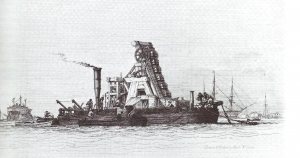Feedback
Plymouth II
General properties
Physical properties
About this page
Last Updated
History
| Timeframe | Equipment | Manager | Review |
|---|---|---|---|
Timeframe:
1808
| Equipment:
| Review:
to contractor Hughes, Bough & Mills
|
About this equipment
In January and May 1806, Trevithick, aged 35, submitted proposals to the lighthouse organisation Trinity House for the dredging of aggregate (for ship ballast) using steam power. They accepted, and he mounted a high pressure engine and a side chain of buckets on the 21.3m long gun brig Blazer. Trinity House loaned the vessel to Trevithick but he later bought it for £300. The 4.5kW steam engine was built at Hazeldine & Co in Bridgnorth and had a 200mm diameter cylinder with a 910mm stroke.
Refitting was completed in July 1806 and the dredger worked in September and October on Barking Shelf in the River Thames. It was a technical success. However, the engine couldn't raise aggregate at the rate Trinity House required and, after further trials in December, Trevithick concluded that a more powerful engine was needed.
He sets to work mounting a bigger engine in ex-navy vessel Plymouth. In the summer, this vessel was working on the Thames at Limehouse. By the end of 1807 he had sold both ships to contractor Hughes, Bough & Mills (est.1806). They remodelled the Plymouth, installing a bucket chain on both sides and an 11.9kW engine by Matthew Murray (1765-1826). By July 1808 she was working at Woolwich.
At first, Trevithick (1771-1833) used the Coalbrookdale foundry (SJ665050) in Shropshire — initially for parts of his first road locomotive Puffing Devil. In about 1803 he decided to try Hazeldine & Co. They cast an engine for him to be used in a dredger, and by 1804 there were seven Trevithick engines being manufactured at the Bridgnorth foundry. In about 1805 they completed a stationary engine labelled “No.14”, now preserved at the Science Museum in London, and two more engines for steam dredgers — Blazer and Plymouth.
Trevithick high pressure stationary engine built by "Hazledine & Co., Bridgnorth", no. 14, c. 1806, with timber staging
Trevithick high pressure stationary engine, three horsepower, c. 1805. In 1802 Richard Trevithick and Andrew Vivian obtained a patent for high-pressure, non-condensing engines. Trevithick went on to develop this particular engine three years afterwards, which used steam pressures of approximately 50 pounds per square inch. It was built by Hazledine & Co
Dredger build by Goodrich
Technical files and datasheets
No files available





